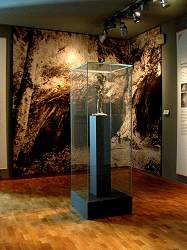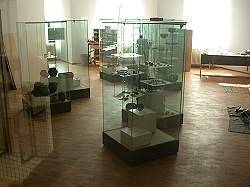Museum Ulm
Archaeological Collection
Useful Information

| Location: |
Marktplatz 9, 89073 Ulm.
In Ulm, Marktplatz, near the historic town hall. (48.3971049, 9.9947315) |
| Open: |
Currently closed for renovation. [2025] |
| Fee: |
Currently closed for renovation. [2025] |
| Classification: | |
| Light: |
 Electric Light Electric Light
|
| Dimension: | |
| Guided tours: | |
| Photography: | not allowed |
| Accessibility: | yes |
| Bibliography: | |
| Address: |
Museum Ulm, Marktplatz 9, 89073 Ulm, Tel. +49-731-161-4300.
E-mail: |
| As far as we know this information was accurate when it was published (see years in brackets), but may have changed since then. Please check rates and details directly with the companies in question if you need more recent info. |
|
History
| JUN-2002 | new archaeological exhibition opened. |
| 2017 | inscribed on the UNESCO WHL. |
| 2025 | Museum closed for renovation. |
Description

Unfortunately, the Ulm Museum is one of the inglorious institutions financed with our tax money that forbids its visitors to take and share pictures of archaeological finds. They are actually paid to inform citizens as comprehensively as possible about our ancestors. They use their funding, which we citizens pay for, to sue us if we have the temerity to post a picture on social media of a work of art that we have paid for to be excavated, renovated and exhibited. Copyright is not really designed for this kind of thing, it was supposed to protect the author, but he died 40,000 years ago. But if you spend enough taxpayers’ money to pay a good lawyer, he’ll find a trick to make us bleed again for something we’ve already paid for several times, and the time they spend in court is also paid for by us. So we’re paying someone to sue us because we published a photo of something that belongs to us and advertised it for free. Am I the only one who is repulsed by this way of thinking?
The Ulm Museum owns a beautiful collection of archaeological items from the Swabian Jura.
Most interesting are the Stone Age finds from the caves of the
 Blautal
(Blau valley) and
Blautal
(Blau valley) and
 Lonetal
(Lone valley).
This is all the more important as these caves and their finds are now included on the UNESCO WHL.
Lonetal
(Lone valley).
This is all the more important as these caves and their finds are now included on the UNESCO WHL.
There are exhibits of all epochs since Old Stone Age.
The oldest remains are more than 40,000 years old.
At this time the Hunters of the Ice Age strolled through the valleys of the Swabian Jura, hunting mammoth, wild horses and deer.
From this early time are the two ivory carvings, the
 Adorant
a human figure from the Geißenklösterle and the
Adorant
a human figure from the Geißenklösterle and the
 Lionheaded Figurine
from the
Lionheaded Figurine
from the
 Lonetal (Lone valley).
Lonetal (Lone valley).
There are remains of all following epochs, like Middle and New Stone Age, Bronze Age, Iron Age, and the Romans. Ulm is still south of the Limes near Aalen, the border which protected the Roman Empire for nearly 300 years.
The archaeological collection was completely overhauled around 2000 and was on display again from June 2002. The main innovation was a magnificent presentation of the newly restored Lionheaded Figurine. At that time, the museum had been called the Ulmer Museum for almost a century. The municipal museum emerged from the city’s art history heritage in 1924, and in addition to various art collections from citizens, an extensive collection of modern art was also built up. This came to an abrupt end under National Socialism, when the paintings were confiscated as Entartete Kunst (degenerate art) and either destroyed or sold off. After the war, the museum was rebuilt and now had three main exhibitions: the history of the city, archaeology and modern art, especially 20th century graphic art. The new name is due to the activism of the new head of the Ulm museum, Stefanie Dathe. We didn’t realise any benefit of the name change, apart from the work involved in correcting the name on dozens of websites. The museum is now being renovated again and is closed, with the reopening scheduled for the end of 2025.
 Subterranean World Heritage List
Subterranean World Heritage List Search DuckDuckGo for "Museum Ulm"
Search DuckDuckGo for "Museum Ulm" Google Earth Placemark
Google Earth Placemark OpenStreetMap
OpenStreetMap Museum Ulm, official site. (
Museum Ulm, official site. ( )
) Index
Index Topics
Topics Hierarchical
Hierarchical Countries
Countries Maps
Maps